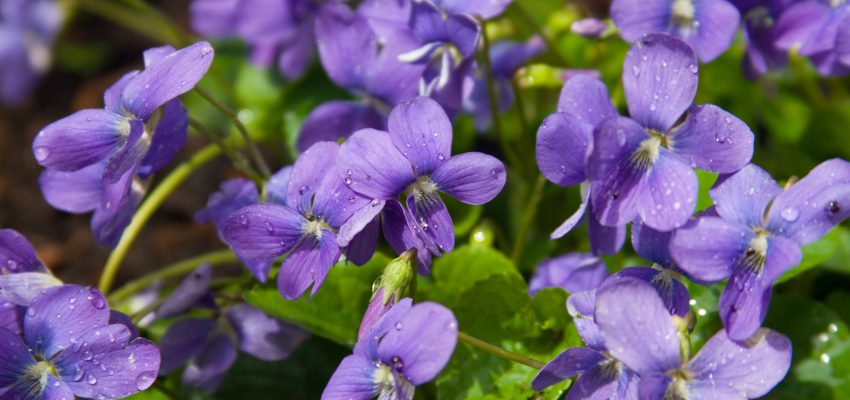Wild blue violets are one of the first flowers to grace your spring garden. While some consider them weeds, the beautiful deep blue flowers and heart-shaped leaves provide a wealth of benefits including culinary and medicinal applications. The wild violets that occur across Canada and the US are known as Viola Odorata. This common blue violet will pop up in your lawn, but also favours damp woodlands and meadows.
The Many Virtues of Violets
The delicate flowers of the violet are edible. Be sure to rinse really well under cold water to remove dirt and bugs that have decided to call your violet patch home. You can add violet flowers to salad for a splash of colour. It’s precisely this vibrant colour that makes them a valuable ingredient as they impart their brilliant blue to infusions. Add a couple of violets to vinegar and leave it to infuse. The violets add not only colour, but fragrance too. This vinegar can be used over salads or in homemade all-purpose cleaners.
Candied violets were a Victorian delicacy that can still add a romantic beauty to your baking. Collect fresh flowers with the stem on and rinse thoroughly. Using a paintbrush, cover a flower in egg white, then sprinkle front and back with castor sugar. Remove the stems and leave to dry overnight. You can store them in an airtight container but place a sheet of parchment paper between layers so they don’t stick to each other.
Violet jelly is a vibrant purple jam that goes perfectly with toast, scones and crumpets. Gather and rinse two heaping cups of violets and place in a glass jug. Pour two cups of boiling water over the violets and leave to steep for about two hours or until the water has a deep purple hue. Strain the infusion and place in a pot on a medium high heat. Add four cups of sugar and ¼ cup of lemon juice. Bring to a roiling boil and add a pouch of liquid pectin. Boil for two minutes and remove from heat. Place in sanitized Mason jars and close the lids. Boil in a water bath for ten minutes.
Violet flowers frozen in ice cubes make a sweet addition to your summer drinks. Fill your ice trays half way and place in the freezer until solid. Add fresh or dried violets and fill the trays to the top. Pop them back in the freezer for a couple of hours.
Medicinal Applications
Violet tea can help to soothe the symptoms of colds including sore throats, and sinus infections. You can make violet tea with fresh flowers or dried, but the flavour will be more pronounced with fresh blooms. Pick violets in the morning and rinse well. To make fresh violet tea, add two to three flowers to a cup of boiling water. Allow to steep for five minutes and serve hot.
For dried flower tea, simply lay the flowers on a drying rack and dry, then add 2-3 teaspoons of violet flowers per cup and allow to steep for five minutes.
Violet leaves are high in fibre and are a good source of Vitamins A and C, and rutin. Studies show rutin has anti-inflammatory properties, is an anti-oxidant, boosts bone density, and helps prevent Alzheimer’s and dementia. You can add fresh leaves to a salad.
In a recent study, researchers found that violet oil helped to reduce insomnia in patients who took the oil intranasally before bed. Need help with medical debt? Click here for more information.
Want to learn more about foraging? Subscribe to our YouTube channel for all the latest posts.




